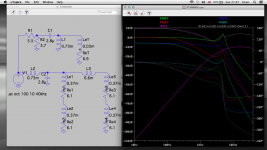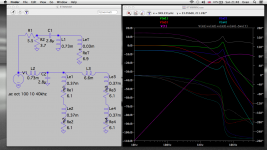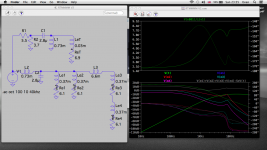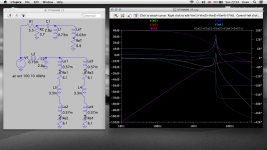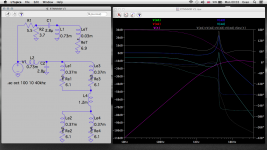I am toying with the idea of a TMMMM (that's 4 M's... quite a mouthful 😀) floor standing speaker using a very efficient ribbon with multiple not efficient but wide range mids to match levels.
Tweeter: RBT-95
Mid: http://www.tymphany.com/files/SDS-P830656 Rev1_0_0.pdf
Both have good reputation for clean low distortion sound, smooth FR, and are cheap as chips.
Could be configured either as a 2.5 or 3 way, and T-MM-MM or T-MMM-M. I think 2.5 way T-MM-MM would be better & easier to work with. Or even 2 way??? 😱
A pair of mids wired in series-then the pairs paralleled which should give a comfortable >4 ohm Z for the amp (4 in parallel would give ~2 ohms so it's a no-no).
These mids can be crossed quite high e.g. 3.5~5khz letting that ribbon sing, whilst keeping clear of mid cone breakup.
LR3~LR4 slopes can hopefully be achieved with a simple 2 part coil & cap low pass & a single cap high pass (maybe too ambitious). Maybe "Quasi-optimal" crossover to match phase & time delay, following the excellent discussion here:
http://www.diyaudio.com/forums/mult...sover-high-efficiency-loudspeaker-system.html
A little crazy project but who knows...!! It could be viable?
I'd welcome any feedback.

Tweeter: RBT-95
Mid: http://www.tymphany.com/files/SDS-P830656 Rev1_0_0.pdf
Both have good reputation for clean low distortion sound, smooth FR, and are cheap as chips.
Could be configured either as a 2.5 or 3 way, and T-MM-MM or T-MMM-M. I think 2.5 way T-MM-MM would be better & easier to work with. Or even 2 way??? 😱
A pair of mids wired in series-then the pairs paralleled which should give a comfortable >4 ohm Z for the amp (4 in parallel would give ~2 ohms so it's a no-no).
These mids can be crossed quite high e.g. 3.5~5khz letting that ribbon sing, whilst keeping clear of mid cone breakup.
LR3~LR4 slopes can hopefully be achieved with a simple 2 part coil & cap low pass & a single cap high pass (maybe too ambitious). Maybe "Quasi-optimal" crossover to match phase & time delay, following the excellent discussion here:
http://www.diyaudio.com/forums/mult...sover-high-efficiency-loudspeaker-system.html
A little crazy project but who knows...!! It could be viable?
I'd welcome any feedback.

Last edited:
4 drivers series parallel = 8Ω x2 power rating, 3dB acoustic gain.
Cross around 3k. Higher will cause lobing, pinching the off axis response.
Active 2.5 way, driver pairs connected in parallel for a 4Ω load to the amp one set for the MTM and a set for the dot 5. The crossover point for the .5 is determined by baffle step loss eg baffle width. Narrow baffle crossing higher forcing placement closer to the MTM. Wider baffle lower this frequency is and placement is further. This distance is the ¼ wavelength of the baffle step
Cross around 3k. Higher will cause lobing, pinching the off axis response.
Active 2.5 way, driver pairs connected in parallel for a 4Ω load to the amp one set for the MTM and a set for the dot 5. The crossover point for the .5 is determined by baffle step loss eg baffle width. Narrow baffle crossing higher forcing placement closer to the MTM. Wider baffle lower this frequency is and placement is further. This distance is the ¼ wavelength of the baffle step
Thanks Greedster that's a good suggestion, so you're saying MTM + MM as the 0.5 way?
I understand the point about the crossing freq. my concern is whether the ribbon will sound good crossed that low (for a ribbon) and its power handling.
Active crossover? I can see why given the complexities but I consider this option uneconomical for a cheap speaker like this and with all respect as a bit of a cop out from proper crossover design (TBH the real reason is I have no experience on those!!). Then again could be a good investment for future work. Hmmm
I understand the point about the crossing freq. my concern is whether the ribbon will sound good crossed that low (for a ribbon) and its power handling.
Active crossover? I can see why given the complexities but I consider this option uneconomical for a cheap speaker like this and with all respect as a bit of a cop out from proper crossover design (TBH the real reason is I have no experience on those!!). Then again could be a good investment for future work. Hmmm
Last edited:
mivoc
look at this ( in german)
Test Selbstbauprojekt - Mivoc K+T "Sixteen" -
speakers are from speakertrade
look at this ( in german)
Test Selbstbauprojekt - Mivoc K+T "Sixteen" -
speakers are from speakertrade
Nice article sonomanie, exactly what greebster what talking about! Interesting use of 16 ohm mids!!
My german is not very good but it looks like he's crossed the planar tweeter at 3khz. Again that sounds slightly too low to me for a ribbon, but I could be wrong.
I don't like the xo!!!! Too many parts 😀
Thanks good link.
My german is not very good but it looks like he's crossed the planar tweeter at 3khz. Again that sounds slightly too low to me for a ribbon, but I could be wrong.
I don't like the xo!!!! Too many parts 😀
Thanks good link.
@ Greebster
Just curious if you were to use an active xo in this design, how would you wire it?
Just curious if you were to use an active xo in this design, how would you wire it?
Last edited:
I was just messing around with ltspice with this text book xo (translation: not going to be very good in the real world but it's a start...)
The first problem is the 6.6mH coil. It needs to be that big (I think) as it sees 16 ohm Z for mid 3 & 4. That alone will probably cost more that a single mid driver so it needs addressing.
The second problem is I can't find any t/s parameters for the rbt-95... the values I used are pure guess work... not a good start.
Third problem mid 1,2 & tweeter are not in true d'apollito as the tweeter lag is not 90deg to mid 1 & 2 at xo freq... that also needs addressing.
Also the levels of mid 1 & 2 (part of the MTM segment) are not the same... oops!! I begin to think this 2.5 way is not possible with 8ohm mids....
2 attachments with normal and reverse polarity. Grey line is the overall FR.
Any feedback?

The first problem is the 6.6mH coil. It needs to be that big (I think) as it sees 16 ohm Z for mid 3 & 4. That alone will probably cost more that a single mid driver so it needs addressing.
The second problem is I can't find any t/s parameters for the rbt-95... the values I used are pure guess work... not a good start.
Third problem mid 1,2 & tweeter are not in true d'apollito as the tweeter lag is not 90deg to mid 1 & 2 at xo freq... that also needs addressing.
Also the levels of mid 1 & 2 (part of the MTM segment) are not the same... oops!! I begin to think this 2.5 way is not possible with 8ohm mids....
2 attachments with normal and reverse polarity. Grey line is the overall FR.
Any feedback?

Attachments
Last edited:
This gives same level for mid 1 & 2 for the mtm part but .... overall Z goes down to 2 ohms...  so it's a no-no.
so it's a no-no.
So really the MTM part needs 16 ohm mids (where driver choice is now limited or more of a stab in the dark) or we just go back to the TMM arrangement (which will exhibit lobing error).
Going back to the first topology posted - are the different dB levels of the series mids that much of a compromise in an MTM arrangement?
 so it's a no-no.
so it's a no-no.So really the MTM part needs 16 ohm mids (where driver choice is now limited or more of a stab in the dark) or we just go back to the TMM arrangement (which will exhibit lobing error).
Going back to the first topology posted - are the different dB levels of the series mids that much of a compromise in an MTM arrangement?
Attachments
Last edited:
or maybe something like these using mid 1 & 3 for mtm? Looks like it might need a lot of work...
Attachments
Last edited:
Yes, active 2.5way. The dot 5 pair crosses in at baffle step.
Indeed this is not going to work unless going active. Still this does not address the lower level of the lower mid in each pair if they are wired series-parallel.
The only way I can see this is if mids are paralleled then each pair connected on separate ways, then the tweeter on the 3rd way, so effectively wired as 3 way / tri-amped but filters adjusted towards 2.5 way operation.
Last edited:
Regarding this post:
http://www.diyaudio.com/forums/mult...less-830656-monacor-rbt-95-a.html#post3775402
I am perplexed by this. I was also looking at zaph's MMTMM & MTMMM design:
Zaph|Audio - ZA5 Speaker Designs with ZA14W08 woofer and Vifa DQ25SC16-04 tweeter
and from his xo design he does not seem to be bothered by this (the lower db is not shown in his individual driver response graph...)
m2 is basically 6db lower than m1, how does that functionally affect the MTM configuration? Is this issue not significant enough????
The same goes for the 0.5 pair, m4 is -6db than the m3...
Has anyone noticed this before in other series-parallel designs?
Help!

http://www.diyaudio.com/forums/mult...less-830656-monacor-rbt-95-a.html#post3775402
Also the levels of mid 1 & 2 (part of the MTM segment) are not the same... oops!!
I am perplexed by this. I was also looking at zaph's MMTMM & MTMMM design:
Zaph|Audio - ZA5 Speaker Designs with ZA14W08 woofer and Vifa DQ25SC16-04 tweeter
and from his xo design he does not seem to be bothered by this (the lower db is not shown in his individual driver response graph...)
m2 is basically 6db lower than m1, how does that functionally affect the MTM configuration? Is this issue not significant enough????
The same goes for the 0.5 pair, m4 is -6db than the m3...
Has anyone noticed this before in other series-parallel designs?
Help!

Last edited:
4 drivers series parallel = 8Ω x2 power rating, 3dB acoustic gain.
Cross around 3k. Higher will cause lobing, pinching the off axis response.
Are you sure?
4 drivers = 4x the power rating, assuming they're all taking equal power: as surely you now have 4 voice coils to heat up, instead of one.
Passive line level filter for the dot 5. Amps are cheap.
It's a idea... but I think I'm not ready for bi-amping just yet ... 😀😀

m2 is basically 6db lower than m1, how does that functionally affect
the MTM configuration? Is this issue not significant enough????
The same goes for the 0.5 pair, m4 is -6db than the m3...
Has anyone noticed this before in other series-parallel designs?
Hi,
I have no idea what issue you are talking
about, the driver levels are the same.
rgds, sreten.
Hi sreten, good to have you here!
I might well be talking rubbish but see attached crossover simulation for your perusal.
Green line for mid 1 seems to be consistently +6db above mid 2 blue line. m1 & m2 are part of the MTM part of a possible MTMMM 2.5 way config. Surely it's not going to work??
I might well be talking rubbish but see attached crossover simulation for your perusal.
Green line for mid 1 seems to be consistently +6db above mid 2 blue line. m1 & m2 are part of the MTM part of a possible MTMMM 2.5 way config. Surely it's not going to work??
Attachments
Hi,
You need far better simulation tools. I suspect your problem
is your looking at absolute voltages, and of course the
voltage across 2 drivers is 6dB higher than across 1.
The voltage across each driver is still the same.
That tweeter won't work well in this sort of build,
you can learn a lot from Zaphs articles, the bassmid
needs the same sort of peak suppression Zaph uses.
Pick another tweeter IMO.
rgds, sreten.
FWIW the Peerlees bassmid may be ideal for a 2 way,
TM, or MTM, but not ideal for a 2.5 way, high Qts at
the bottom end, and a general downtilt probably
means a 2.5 way with 6dB of BSC is too much.
You need far better simulation tools. I suspect your problem
is your looking at absolute voltages, and of course the
voltage across 2 drivers is 6dB higher than across 1.
The voltage across each driver is still the same.
That tweeter won't work well in this sort of build,
you can learn a lot from Zaphs articles, the bassmid
needs the same sort of peak suppression Zaph uses.
Pick another tweeter IMO.
rgds, sreten.
FWIW the Peerlees bassmid may be ideal for a 2 way,
TM, or MTM, but not ideal for a 2.5 way, high Qts at
the bottom end, and a general downtilt probably
means a 2.5 way with 6dB of BSC is too much.
Last edited:
Hi,
You need far better simulation tools. I suspect your problem
is your looking at absolute voltages, and of course the
voltage across 2 drivers is 6dB higher than across 1.
The voltage across each driver is still the same.
That tweeter won't work well in this sort of build,
you can learn a lot from Zaphs articles, the bassmid
needs the same sort of peak suppression Zaph uses.
Pick another tweeter IMO.
rgds, sreten.
FWIW the Peerlees bassmid may be ideal for a 2 way,
TM, or MTM, but not ideal for a 2.5 way, high Qts at
the bottom end, and a general downtilt probably
means a 2.5 way with 6dB of BSC is too much.
You are quite right about taking the voltage across 2 drivers!!! It's so obvious now...!!
Yes I do realise I need a tweeter able to be crossed lower than this ribbon. I was thinking of a compact neodymium dome one to fit snuggly between the mids.
Indeed I do need better simulation tools. I am trying to get speaker workshop to run on win7 but to no avail...
You are also right about the mid suppression, bear with me I haven't optimised the xo yet at all.
About your point on Qts, I think what you are saying is, for 0.5 way these drivers would require too much volume to sound right at lower frequencies?
Could this be addressed by a large separate chamber within the speaker? Will play with unibox a bit to see what Vb it comes up with. Or could find a different (larger) woofer but then it won't be the slender tower I envisaged !!
Cheers

Last edited:
Hi,
For a highish Qts mid bass your looking at some bass peaking,
or stupidly large cabinets to avoid it. It reduces the amount of
BSC required. Drivers with downtilted responses reduce BSC.
0.5 way gives 6dB of BSC and with that driver it may be too much.
rgds, sreten.
For a highish Qts mid bass your looking at some bass peaking,
or stupidly large cabinets to avoid it. It reduces the amount of
BSC required. Drivers with downtilted responses reduce BSC.
0.5 way gives 6dB of BSC and with that driver it may be too much.
rgds, sreten.
- Status
- Not open for further replies.
- Home
- Loudspeakers
- Multi-Way
- TMMMM Peerless 830656 & Monacor RBT-95
